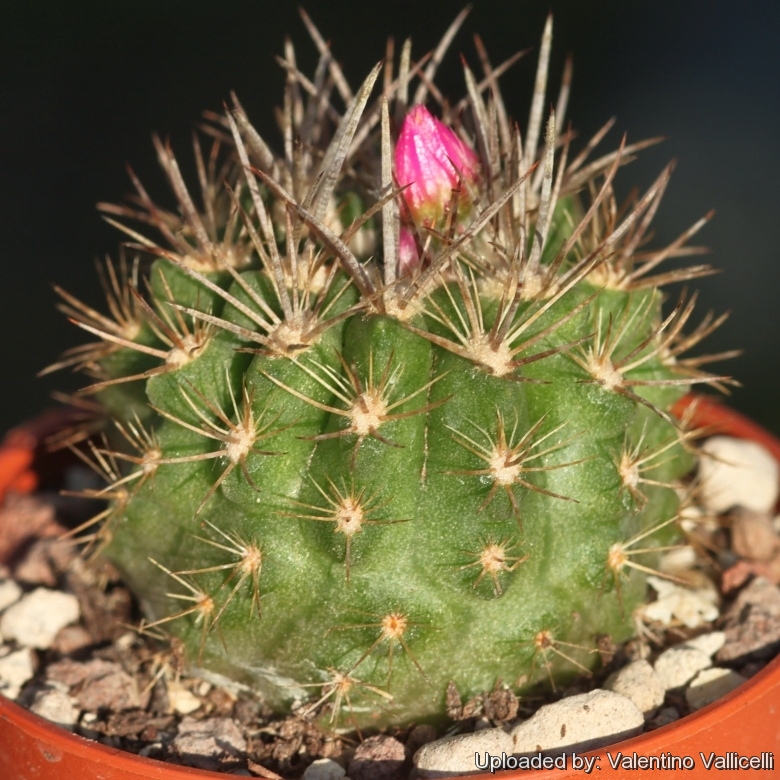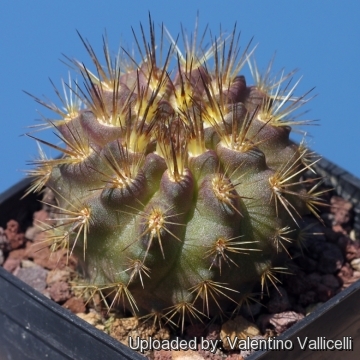Donate now to support the LLIFLE projects.
Your support is critical to our success.
Your support is critical to our success.
Accepted Scientific Name: Eriosyce subgibbosa subs. clavata (Söhrens ex K.Schum.) Katt.
Eriosyce (Cactac.) gen. revis. & ampl. (Succ. Pl. Res., 1) 119 (1994)

Eriosyce subgibbosa ssp. wagenknechtii v. napina FK178-79 (Collector: Friedrich Kattermann) 1km East of Cruz Grande, Elqui, Chil
Synonyms:
See all synonyms of Eriosyce subgibbosa
back
Accepted name in llifle Database:Eriosyce subgibbosa (Haw.) Katt.
Eriosyce (Cactac.) gen. revis. & ampl. (Succ. Pl. Res., 1) 119 (1994)
Synonymy: 69
- Eriosyce subgibbosa (Haw.) Katt.
- Chilenia subgibbosa (Haw.) Backeb.
- Euporteria subgibbosa (Haw.) Kreuz. & Buining
- Neoporteria subgibbosa (Haw.) Britton & Rose
- Eriosyce subgibbosa f. acutissima (Otto & A.Dietr.)
- Chilenia acutissima (Otto & A.Dietr.) Backeb.
- Echinocactus acutissimus Otto & A.Dietr.
- Euporteria acutissima (Otto & A.Dietr.) Kreuz. & Buining
- Neoporteria acutissima (Otto & A.Dietr.) Borg
- Eriosyce subgibbosa var. castanea (F.Ritter) Katt.
- Eriosyce castanea F.Ritter
- Neoporteria castanea F.Ritter
- Neoporteria subgibbosa var. castanea (F.Ritter) Ferryman
- Eriosyce subgibbosa f. castaneoides (Cels ex Salm-Dyck)
- Chilenia castaneoides (Cels ex Salm-Dyck) Backeb.
- Echinocactus castaneoides Cels ex Salm-Dyck
- Euporteria castaneoides (Cels ex Salm-Dyck) Kreuz. & Buining
- Neoporteria castaneoides (Cels ex Salm-Dyck) Werderm.
- Neoporteria subgibbosa f. castaneoides (Cels ex Salm-Dyck) Donald & G.D.Rowley
- Eriosyce subgibbosa f. chionacantha (Y.Itô)
- Eriosyce subgibbosa f. exsculpta (Otto ex Pfeiff.)
- Echinocactus exsculptus Otto ex Pfeiff.
- Neoporteria exsculpta (Otto ex Pfeiff.) Borg
- Eriosyce subgibbosa f. graciana (F.Ritter)
- Eriosyce subgibbosa f. heteracantha (Kreuz. & Buining)
- Chilenia heteracantha Backeb.
- Euporteria heteracantha Kreuz. & Buining
- Neoporteria heteracantha Backeb.
- Neoporteria subgibbosa f. heteracantha (Backeb.) Donald & G.D.Rowley
- Eriosyce subgibbosa var. litoralis (F.Ritter) Katt.
- Neoporteria litoralis F.Ritter
- Neoporteria litoralis var. intermedia
- Neoporteria litoralis var. robustispina Y.Itô
- Neoporteria subgibbosa var. intermedia (F.Ritter) A.E.Hoffm.
- Neoporteria subgibbosa var. litoralis (F.Ritter) A.E.Hoffm.
- Neoporteria subgibbosa f. litoralis (F.Ritter) Donald & G.D.Rowley
- Eriosyce subgibbosa f. major (Backeb.)
- Chilenia nigrihorrida var. major Backeb.
- Neoporteria nigrihorrida var. major Backeb.
- Neoporteria subgibbosa f. major (Backeb.) Donald & G.D.Rowley
- Eriosyce subgibbosa f. microsperma (F.Ritter)
- Neoporteria microsperma F.Ritter
- Neoporteria subgibbosa f. microsperma (F.Ritter) Donald & G.D.Rowley
- Neoporteria wagenknechtii var. microsperma (F.Ritter) A.E.Hoffm.
- Eriosyce subgibbosa f. minor (Backeb.)
- Chilenia nigrihorrida var. minor Backeb.
- Neoporteria nigrihorrida var. minor Backeb.
- Neoporteria subgibbosa f. minor (Backeb.) Donald & G.D.Rowley
- Eriosyce subgibbosa f. orientalis (F.Ritter)
- Eriosyce subgibbosa f. rostrata (Jacobi)
- Chilenia rostrata (Jacobi) Backeb.
- Echinocactus rostratus Jacobi
- Hildmannia rostrata (Jacobi) Kreuz. & Buining
- Neochilenia rostrata (Jacobi) Backeb.
- Eriosyce subgibbosa f. serenana (F.Ritter)
- Neoporteria microsperma var. serenana F.Ritter & Y.Itô
- Neoporteria subgibbosa f. serenana (F.Ritter) Donald & G.D.Rowley
- Eriosyce subgibbosa f. subcylindrica (Backeb.)
- Chilenia subcylindrica Backeb.
- Euporteria subcylindrica Kreuz. & Buining
- Neoporteria subcylindrica (Backeb.) Backeb.
- Neoporteria subgibbosa f. subcylindrica (Backeb.) Donald & G.D.Rowley
- Eriosyce subgibbosa f. tunensis (F.Ritter)
- Neoporteria castanea var. tunensis F.Ritter
- Neoporteria subgibbosa f. tunensis (F.Ritter) Donald & G.D.Rowley
- Neoporteria cachitaensis n.n., catalog name
Eriosyce subgibbosa subs. clavata (Söhrens ex K.Schum.) Katt.
Eriosyce (Cactac.) gen. revis. & ampl. (Succ. Pl. Res., 1) 119 (1994)
Synonymy: 40
- Eriosyce subgibbosa subs. clavata (Söhrens ex K.Schum.) Katt.
- Arequipa clavata (Söhrens) Borg
- Echinocactus clavatus Söhrens
- Eriosyce clavata (Söhrens ex K.Schum.) Helmut Walter
- Euporteria clavata (Söhrens) Kreuz. & Buining
- Neoporteria clavata (Söhrens ex K.Schum.) Werderm.
- Eriosyce subgibbosa var. nigrihorrida (Backeb. ex A.W.Hill) Katt.
- Chilenia nigrihorrida Backeb. ex A.W.Hill
- Chilenia nigrihorrida Backeb.
- Echinocactus nigrihorridus
- Eriosyce clavata subs. nigrihorrida (Backeb. ex A.W.Hill) Helmut Walter
- Eriosyce subgibbosa subs. nigrihorrida (Backeb. ex A.W.Hill) Katt.
- Euporteria nigrihorrida (Backeb. ex A.W.Hill) Kreuz. & Buining
- Neoporteria clavata var. nigrihorrida (Backeb.) A.E.Hoffm.
- Neoporteria nigrihorrida (Backeb. ex A.W.Hill) Backeb.
- Neoporteria nigrispina n.n.
- Neoporteria subgibbosa var. nigrihorrida (Backeb.) Donald & G.D.Rowley
- Eriosyce subgibbosa f. rapifera (F.Ritter & Y.Itô)
- Neoporteria rapifera F.Ritter & Y.Itô
- Eriosyce subgibbosa var. vallenarensis (F.Ritter) Katt.
- Eriosyce subgibbosa subs. vallenarensis (F.Ritter) Katt.
- Horridocactus vallenarensis (F.Ritter) Backeb.
- Neoporteria curvispina var. vallenarensis (F.Ritter) Donald & G.D.Rowley
- Neoporteria subgibbosa var. vallenarensis (F.Ritter) Katt.
- Neoporteria vallenarensis F.Ritter
- Neoporteria wagenknechtii var. vallenarensis (F.Ritter) A.E.Hoffm.
- Pyrrhocactus vallenarensis F.Ritter
- Eriosyce subgibbosa var. wagenknechtii (F.Ritter) Katt.
- Eriosyce subgibbosa subs. wagenknechtii (F.Ritter) Katt.
- Neochilenia wagenknechtii (F.Ritter) Backeb.
- Neoporteria jussieui var. wagenknechtii (F.Ritter) A.E.Hoffm.
- Neoporteria wagenknechtii F.Ritter
- Pyrrhocactus wagenknechtii F.Ritter
- Eriosyce subgibbosa var. wagenknechtii f. napina (F.Ritter)
- Neoporteria clavata f. grandiflora F.Ritter
- Neoporteria clavata f. parviflora F.Ritter
- Eriosyce clavata var. parviflora (F.Ritter)
- Eriosyce nigrihorrida var. parviflora (F.Ritter) hort.
- Neoporteria clavata f. procera F.Ritter
back

Eriosyce subgibbosa var. wagenknechtii f. napina Photo by: Valentino Vallicelli
Send a photo of this plant.
The gallery now contains thousands of pictures, however it is possible to do even more. We are, of course, seeking photos of species not yet shown in the gallery but not only that, we are also looking for better pictures than those already present. Read More...
The gallery now contains thousands of pictures, however it is possible to do even more. We are, of course, seeking photos of species not yet shown in the gallery but not only that, we are also looking for better pictures than those already present. Read More...
| Your Actions | |
|---|---|
| Back to Eriosyce index | |
| Back to Cactaceae index | |
 |
Back to Cacti Encyclopedia index |









